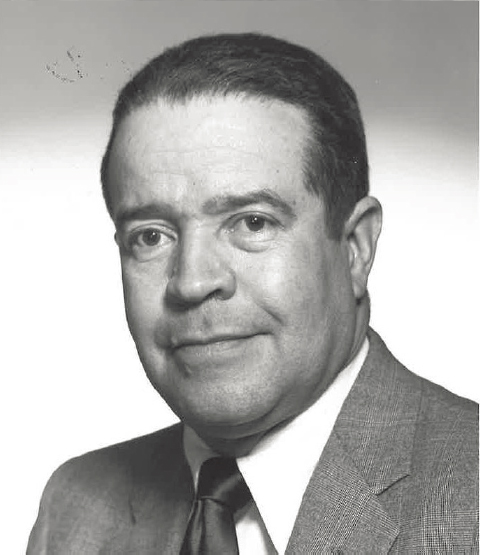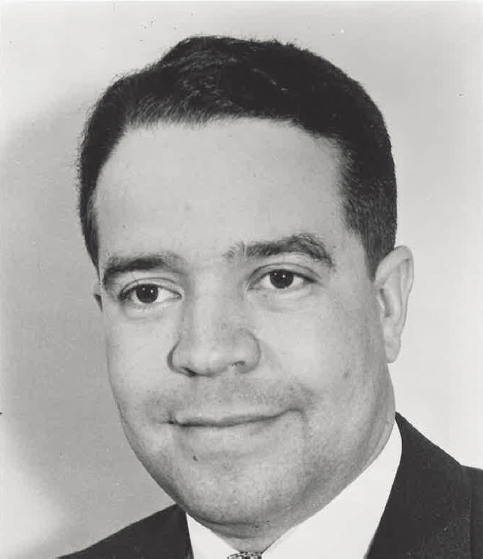J. ERNEST WILKINS JR.
1923–2011
Elected in 1976
“Peaceful application of atomic energy through contributions to the design and development of nuclear reactors.”
BY PERCY A. PIERRE
JESSE ERNEST WILKINS JR. was a legend in the Black community and beyond. He was a child prodigy and became an outstanding mathematician and engineer. He passed away at age 87 on May 1, 2011, in Fountain Hills, Arizona.
J. Ernest, as he was called, was born in Chicago on November 27, 1923, to J. Ernest and Lucile Beatrice Robinson Wilkins. His father was a prominent attorney and assistant secretary of the Department of Labor during the Eisenhower administration; his mother held a master’s degree and taught in the Chicago Public School system.
The younger J. Ernest entered the University of Chicago at 13 years of age—the institution’s youngest student ever—and, after earning his BS (1940) and MS (1941), received his PhD (1942), all in mathematics, at age 19. In 1942 he won a Rosenwald Scholarship and studied at the Institute for Advanced Study in Princeton. He wrote his first papers that year, both on geometry. 1
Although he was recognized as a “genius,” in the 1940s and 1950s Black scientists and engineers had limited job choices.
___________________
1 Wilkins JE Jr. 1943. The first canonical pencil. Duke Mathematical Journal 10(2):173–78; Wilkins JE Jr. 1945. A special class of surfaces in projective differential geometry. Duke Mathematical Journal 12:397–408.
Some major universities accepted Blacks as students but not as faculty. J. Ernest’s first job after he got his PhD was teaching mathematics at the Tuskegee Institute (now Tuskegee University), one of this country’s historically Black colleges and universities (HBCUs).
In 1944 he joined the University of Chicago Metallurgical (Met) Lab, working on the Manhattan Project. His team was scheduled to be transferred to Oak Ridge, Tennessee, in the fall of 1944, but Jim Crow laws prevented him from taking a scientific post there. Instead, Edward Teller (NAS 1948) recommended him for a position with Eugene Wigner (NAS 1945), who at the time was researching the design and development of nuclear reactors that would convert uranium into weapons-grade plutonium.
From 1944 to 1946 Wilkins collaborated with Wigner at the Met Lab on research in neutron absorption, leading to their discovery of the Wigner-Wilkins approach for estimating the distribution of neutron energies in nuclear reactors. Their paper, “Effect of the Temperature of the Moderator on the Velocity Distribution of Neutrons with Numerical Calculations for H as Moderator,” written in 1944 and declassified in 1948, was eventually published in Wigner’s Collected Works (Springer-Verlag Berlin Heidelberg, 1993).
Working with Arthur Compton (NAS 1927) and Enrico Fermi (NAS 1945) in the early 1940s, Wilkins researched methods for producing fissionable nuclear materials, focusing on plutonium-239. He made major contributions to the Manhattan Project 2 and nuclear engineering, including the formulation of mathematical models to explain gamma radiation, which was critical to the development of shielding against gamma radiation emitted by nuclear sources and the sun and thus key to the design of safe nuclear reactors and space probes.
After World War II Wilkins worked as a mathematician for the American Optical Company (1946–50) in Buffalo, New York, designing and testing optical techniques for microscopes,
___________________
2 He was not told of the ultimate goal of the work until after the atomic bomb was dropped on Hiroshima on August 6, 1945.
telescopes, and other ophthalmologic uses. He then went to work at the United Nuclear Corporation, which later became General Dynamics (1950–60), in White Plains, NY; while there, he continued his academic pursuits and earned both BA (1957) and MA (1960) degrees in mechanical engineering from New York University. He then took a job as assistant chair of theoretical physics at General Atomic Company in San Diego; during his decade there he was promoted to assistant director of defense science and engineering and then director of computational research.
In 1970 he was hired as Distinguished Professor of Applied Mathematical Physics at Howard University, where he established the university’s PhD program in mathematics. He had his choice of going to other universities but chose Howard, acting on his lifelong commitment to the Black community.
He left academia to work in nuclear engineering at EG&G, Inc., a scientific technology firm in Idaho Falls (1977–84), where he rose from vice president and associate general manager for science and engineering to vice president and deputy general manager for science and engineering, before accepting a term as a fellow at the Department of Energy’s Argonne National Laboratory (1984–85). After retiring from Argonne, he returned to academia in 1990, as Distinguished Professor of Applied Mathematics and Mathematical Physics at Clark Atlanta University, a position he held until his retirement in 2003. During his academic career he was thesis or dissertation advisor for 22 minority graduate students.
I met J. Ernest in 1972 when I was dean of engineering at Howard. In 1977, when I became assistant secretary of the Army for Research, Development, and Acquisition, I asked J. Ernest to chair the Army Science Board (1978–81). The ASB “provides the Army with independent advice and recommendations on matters relating to the Army’s scientific, technological, manufacturing, logistics, and business management functions, as well as other matters the Secretary of the Army deems important to the Department of the Army.” During his tenure as chair, the ASB provided advice on matters ranging from basic science to the development of advanced weapons systems.
He also served in other ways. He was an active member of the American Mathematical Society (council member, 1975–77), American Association for the Advancement of Science (elected a fellow in 1956), Mathematical Association of America, Institute of Mathematical Statistics, Optical Society of America, Society for Industrial and Applied Mathematics, American Nuclear Society (board of directors, 1967–77; president, 1974–75), American Society of Mechanical Engineers, Association for Computing Machinery, and National Association of Mathematicians. He also served on board of directors of Oak Ridge National Laboratory.
For the National Research Council, he was appointed to the Ford Foundation Diversity Fellowships Predoctoral Review Panel on Engineering (1999, 2000, 2001), Committee for a Decadal Study of the Mathematical Sciences (1999–2000), and US National Commission on Mathematics Instruction (1995–98).
J. Ernest was recognized by his colleagues and peers for his outstanding work. He was elected to the NAE in 1976—the second African American to join its esteemed ranks. He received the US Army’s Outstanding Civilian Service Medal (1980); was an honorary life member of the National Association of Mathematicians and recipient of its Lifetime Achievement Award (1994); and he received the QEM Network’s Giant in Science Award (1994), DOE Special Recognition Award (1996), and Professional Achievement Citation (1997) from the University of Chicago Alumni Association. He was elected to Phi Beta Kappa (1940), Sigma Xi (1942), Pi Tau Sigma (1956), and Tau Beta Pi (1956).
During his term as ASB chair, J. Ernest and the board members traveled around the world to visit Army sites. Once when they were in the Las Vegas area they went to a casino. It turns out that J. Ernest liked to play blackjack. He had a photographic memory and won a lot—but not too much; had he won too much, they would have kicked him out. His colleagues were impressed.
He was predeceased by his wives Gloria Louise Stewart, whom he married in 1947, and Maxine G. Malone. He is survived by a daughter and son from his first marriage, Sharon Wilkins Hill and J. Ernest Wilkins III.








